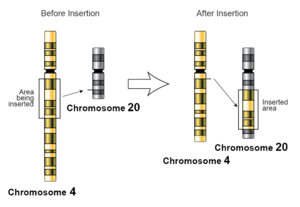Insertion (genetics)

In
N region addition is the addition of non-coded nucleotides during recombination by terminal deoxynucleotidyl transferase.
P nucleotide insertion is the insertion of palindromic sequences encoded by the ends of the recombining gene segments.
Trinucleotide repeats are classified as insertion mutations[2][3] and sometimes as a separate class of mutations.[4]
Methods
Based on CRISPR/Cas tools, different systems have already been developed to achieve specific functions. For example, one strategy is double-strand nucleases cutting system, using the normal Cas9 protein with single guide RNA (sgRNA) and then achieving the gene insertion through end-joining or dividing cells with the DNA repair system.[5] Another example is the prime editing system, which uses Cas9 nickase and the prime editing guide RNA (pegRNA) carrying the target genes.[5]
One limitation of current technology is that the size for DNA precise insertion is not large enough[6] to meet the demand for genome research. RNA-guided DNA transposition is an emerging area to solve this problem.[7] More efficient methods are expected to be developed and applied in the genome engineering area.
Effects
Insertions can be particularly hazardous if they occur in an
In-frame insertions occur when the reading frame is not altered as a result of the insertion; the number of inserted nucleotides is divisible by three. The reading frame remains intact after the insertion and translation will most likely run to completion if the inserted nucleotides do not code for a stop codon. However, because of the inserted nucleotides, the finished protein will contain, depending on the size of the insertion, multiple new amino acids that may affect the function of the protein.
See also
- Indel
- Insertional mutagenesis
- Loss-of-Function Mutations
- Gain-of-Function Mutations
- Deletion (genetics)
References
- PMID 23692220.
- ^ "Mechanisms: Genetic Variation: Types of Mutations". Evolution 101: Understanding Evolution For Teachers. University of California Museum of Paleontology. Archived from the original on 2009-04-14. Retrieved 2009-09-19. ] Understanding Evolution For Teachers Home. Retrieved on September 19, 2009
- ISBN 978-0-8153-4138-3.
- ISBN 978-1-57230-479-6.
- ^ S2CID 256820370.
- S2CID 258311438.
- S2CID 255966509.
- S2CID 2737235.
Further reading
- Pierce, Benjamin A. (2013). Genetics: A Conceptual Approach (5th ed.). W. H. Freeman. ISBN 978-1-4641-5084-5.
